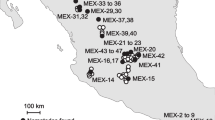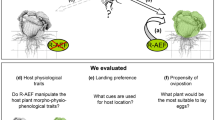Abstract
Plants under attack by arthropod herbivores often emit volatile compounds from their leaves that attract natural enemies of the herbivores. Here we report the first identification of an insect-induced belowground plant signal, (E)-β-caryophyllene, which strongly attracts an entomopathogenic nematode. Maize roots release this sesquiterpene in response to feeding by larvae of the beetle Diabrotica virgifera virgifera, a maize pest that is currently invading Europe. Most North American maize lines do not release (E)-β-caryophyllene, whereas European lines and the wild maize ancestor, teosinte, readily do so in response to D. v. virgifera attack. This difference was consistent with striking differences in the attractiveness of representative lines in the laboratory. Field experiments showed a fivefold higher nematode infection rate of D. v. virgifera larvae on a maize variety that produces the signal than on a variety that does not, whereas spiking the soil near the latter variety with authentic (E)-β-caryophyllene decreased the emergence of adult D. v. virgifera to less than half. North American maize lines must have lost the signal during the breeding process. Development of new varieties that release the attractant in adequate amounts should help enhance the efficacy of nematodes as biological control agents against root pests like D. v. virgifera.
This is a preview of subscription content, access via your institution
Access options
Subscribe to this journal
Receive 51 print issues and online access
$199.00 per year
only $3.90 per issue
Buy this article
- Purchase on Springer Link
- Instant access to full article PDF
Prices may be subject to local taxes which are calculated during checkout






Similar content being viewed by others
References
Karban, R. & Baldwin, I. Induced Responses to Herbivory (Univ. Press Chicago, Chicago, 1997)
Agrawal, A. A., Tuzun, S. & Bent, E. Induced Plant Defenses Against Pathogens and Herbivores (APS Press, St Paul, Minnesota, 1999)
Dicke, M. & Sabelis, M. W. How plants obtain predatory mites as bodyguards. Neth. J. Zool. 38, 148–165 (1988)
Turlings, T. C. J., Tumlinson, J. H. & Lewis, W. J. Exploitation of herbivore-induced plant odors by host-seeking parasitic wasps. Science 250, 1251–1253 (1990)
De Moraes, C. M., Lewis, W. J., Paré, P. W., Alborn, H. T. & Tumlinson, J. H. Herbivore-infested plants selectively attract parasitoids. Nature 393, 570–573 (1998)
Thaler, J. S. Jasmonate-inducible plant defences cause increased parasitism of herbivores. Nature 399, 686–688 (1999)
Kessler, A. & Baldwin, I. T. Defensive function of herbivore-induced plant volatile emissions in nature. Science 291, 2141–2144 (2001)
Khan, Z. R. et al. Intercropping increases parasitism of pests. Nature 388, 631–632 (1997)
Boff, M. I. C., Zoon, F. C. & Smits, P. H. Orientation of Heterorhabditis megidis to insect hosts and plant roots in a Y-tube sand olfactometer. Entomol. Exp. Appl. 98, 329–337 (2001)
van Tol, R. W. H. M. et al. Plants protect their roots by alerting the enemies of grubs. Ecol. Lett. 4, 292–294 (2001)
Osteen, C. in Agricultural Resources and Environmental Indicators, 2003 (ed. Heimlich, R.) 1–44 (Economic Research Service, Washington DC, 2003)
Krysan, J. L. & Miller, T. A. Methods for the Study of the Pest Diabrotica (Springer, New York, 1986)
Kuhlmann, U. & van der Burgt, W. A. C. M. Possibilities for biological control of the western corn rootworm, Diabrotica virgifera virgifera LeConte, in Central Europe. BioControl 19, 59N–68N (1998)
Kaya, H. K. & Gaugler, R. Entomopathogenic nematodes. Annu. Rev. Entomol. 38, 181–206 (1993)
Gaugler, R. Ecological considerations in the biological-control of soil-inhabiting insects with entomopathogenic nematodes. Agric. Ecosyst. Environ. 24, 351–360 (1988)
Turlings, T. C. J., Lengwiler, U. B., Bernasconi, M. L. & Wechsler, D. Timing of induced volatile emissions in maize seedlings. Planta 207, 146–152 (1998)
Gouinguene, S., Degen, T. & Turlings, T. C. J. Variability in herbivore-induced odour emissions among maize cultivars and their wild ancestors (teosinte). Chemoecology 11, 9–16 (2001)
Degen, T., Dillmann, C., Marion-Poll, F. & Turlings, T. C. J. High genetic variability in herbivore-induced volatile emission within a broad range of maize inbred lines. Plant Physiol. 135, 1928–1938 (2004)
Fedoroff, N. V. Prehistoric GM corn. Science 302, 1158–1159 (2003)
Jaenicke-Despres, V. et al. Early allelic selection in maize as revealed by ancient DNA. Science 302, 1206–1208 (2003)
Hammack, L. Single and blended maize volatiles as attractants for diabroticite corn rootworm beetles. J. Chem. Ecol. 27, 1373–1390 (2001)
O'Halloran, D. M. & Burnell, A. M. An investigation of chemotaxis in the insect parasitic nematode Heterorhabditis bacteriophora . Parasitology 127, 375–385 (2003)
Grewal, P. S., Lewis, E. E., Gaugler, R. & Campbell, J. F. Host finding behavior as a predictor of foraging strategy in entomopathogenic nematodes. Parasitology 108, 207–215 (1994)
Grewal, P. S., Lewis, E. E. & Gaugler, R. Response of infective stage parasites (Nematoda: Steinernematidae) to volatile cues from infected hosts. J. Chem. Ecol. 23, 503–515 (1997)
Lewis, E. E., Gaugler, R. & Harrison, R. Response of cruiser and ambusher entomopathogenic nematodes (Steinernematidae) to host volatile cues. Can. J. Zool. 71, 765–769 (1993)
Lewis, E. E., Grewal, P. S. & Gaugler, R. Hierarchical order of host cues in parasite foraging strategies. Parasitology 110, 207–213 (1995)
Sotelo, A. in Functionality of Food Phytochemicals (eds Jones, T. & Romeo, J.) 89–111 (Plenum, New York, 1997)
Baufeld, P. & Enzian, S. in Western Corn Rootworm: Ecology and Management (eds Vidal, S., Kuhlmann, U. & Edwards, C. R.) 285–302 (CABI, Wallingford, 2005)
Journey, A. M. & Ostlie, K. R. Biological control of the western corn rootworm (Coleoptera: Chrysomelidae) using the entomopathogenic nematode, Steinernema carpocapsae . Environ. Entomol. 29, 822–831 (2000)
Levine, E. & Oloumisadeghi, H. Management of diabroticite rootworms in corn. Annu. Rev. Entomol. 36, 229–255 (1991)
Poinar, G. O., Evans, J. S. & Schuster, E. Field test of the entomogenous nematode, Neoaplectana carpocapsae, for control of corn-rootworm larvae (Diabrotica sp., Coleoptera). Protection Ecol. 5, 337–342 (1983)
Ellsbury, M. M., Jackson, J. J., Woodson, W. D., Beck, D. L. & Stange, K. A. Efficacy, application distribution, and concentration by stemflow of Steinernema carpocapsae (Rhabditida: Steinernematidae) suspensions applied with a lateral-move irrigation system for corn rootworm (Coleoptera: Chrysomelidae) control in maize. J. Econ. Entomol. 89, 74–81 (1996)
Jackson, J. J. Field performance of entomopathogenic nematodes for suppression of western corn rootworm (Coleoptera: Chrysomelidae). J. Econ. Entomol. 89, 366–372 (1996)
van der Putten, W. H., Vet, L. E. M., Harvey, J. A. & Waeckers, F. L. Linking above- and belowground multitrophic interactions. Trends Ecol. Evol. 16, 547–554 (2001)
Wardle, D. A. et al. Ecological linkages between aboveground and belowground biota. Science 304, 1629–1633 (2004)
Hass, B., Griffin, C. T. & Downes, M. J. Persistence of Heterorhabditis infective juveniles in soil: Comparison of extraction and infectivity measurements. J. Nematol. 31, 508–516 (1999)
Curran, J. Influence of application method and pest population-size on the field efficacy of entomopathogenic nematodes. J. Nematol. 24, 631–636 (1992)
Turlings, T. C. J., Davison, A. C. & Tamo, C. A six-arm olfactometer permitting simultaneous observation of insect attraction and odour trapping. Physiol. Entomol. 29, 45–55 (2004)
Köllner, T. G., Schnee, C., Gershenzon, J. & Degenhardt, J. The sesquiterpene hydrocarbons of maize (Zea mays) form five groups with distinct developmental and organ-specific distribution. Phytochemistry 65, 1895–1902 (2004)
König, W. A., Bulow, N. & Saritas, Y. Identification of sesquiterpene hydrocarbons by gas phase analytical methods. Flav. Fragr. J. 14, 367–378 (1999)
Acknowledgements
We thank the members of the group of M. Rahier for their continuous support; and M.-E. Farine for technical assistance; R. Gaugler, J. Tumlinson and R. van Tol for useful feedback; and V. Larraz for rearing the Diabrotica larvae for laboratory experiments. Field sites were provided by the Plant Health Service in Hodmézövásárhely, Hungary. Nematodes were provided, free of charge, by Andermatt Biocontrol AG. The work was supported by the Swiss National Centre of Competence in Research ‘Plant Survival’, the Swiss National Science Foundation, the German National Science Foundation and the Max Planck Society.
Author information
Authors and Affiliations
Corresponding author
Ethics declarations
Competing interests
The authors declare that they have no competing financial interests.
Rights and permissions
About this article
Cite this article
Rasmann, S., Köllner, T., Degenhardt, J. et al. Recruitment of entomopathogenic nematodes by insect-damaged maize roots. Nature 434, 732–737 (2005). https://doi.org/10.1038/nature03451
Received:
Accepted:
Issue Date:
DOI: https://doi.org/10.1038/nature03451
This article is cited by
-
Nematode spatial distribution in the service of biological pest control
Egyptian Journal of Biological Pest Control (2024)
-
Volatile methyl jasmonate from roots triggers host-beneficial soil microbiome biofilms
Nature Chemical Biology (2024)
-
Solvent Extraction of PDMS Tubing as a New Method for the Capture of Volatile Organic Compounds from Headspace
Journal of Chemical Ecology (2024)
-
The Sublime Art of War
Resonance (2024)
-
Analysis of root volatiles and functional characterization of a root-specific germacrene A synthase in Artemisia pallens
Planta (2024)
Comments
By submitting a comment you agree to abide by our Terms and Community Guidelines. If you find something abusive or that does not comply with our terms or guidelines please flag it as inappropriate.



